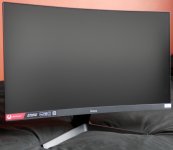
G2466HSU Review
Introduction
With so many monitors being available today finding one that suits your needs can be a real chore and a minefield so it’s no surprise that many people consider finding a new monitor that suits them can feel like an impossible task. As part of my recent series of reviews to bring some clarity to this today we will be looking at the £140 Iiyama G2466HSU, one of four monitors in this review series along with the LG 24GN600-B I recently reviewed and the G2470HSU and BenQ EX2710S in upcoming reviews. Introductions aside it’s time to start taking a look at the G2466HSSU and how it performs.
Gallery


First impressions are pretty impressive with the monitor having a curved screen, the design of the monitor overall is also very sleek and feels of good build quality but much like the LG monitor the stand is quite low which might not suit everyone. Unlike the LG monitor Iiyama do package their monitor in a box worth showing, not just a bland brown box. When looking at a product it is often the box that catches the eye before the product itself especially in brick and mortar stores so it’s nice to see Iiyama putting some effort in here.

A look at the rear of the Iiyama shows just how sleek this monitor is and unlike the LG monitor does also include VESA mounting screws. Also of note is the stand on the Iiyama when completely removed doesn’t expose an ugly metal lump sticking out it’s all sleek and tidy, you can’t say the same for the LG. Orientation of the ports on the Iiyama is also much better pointing straight down which is ideal for flush wall mounting and keeping things tidier in general while also not introducing any unnecessary kinks in wires which can lead to breaks. Of big note is that the power supply for the Iiyama is built into the monitor, the way it should be done, not an ugly separate AC adapter, I’m looking at you again, LG 24GN600-B. Lastly we see that the 2466HSU also uses a joystick for OSD navigation which is far superior to the old clumsy button method making navigation slick and easy.
Specification
VA Panel Size: 23.8” (23.6” viewable)
Resolution: 1920*1080
Typical Brightness: 250 nits
sRGB Coverage: 96% (typical)
Static Contrast: 3000:1
Response Time: 8ms GtG (Estimated), 1ms MPRT
HDR Capable: Yes, basic
G-Sync & FreeSync Compatible: Yes
Refresh Rate: 165Hz
Connectivity: 2x HDMI 2.0, 1x DP 1.4, Headphone socket, 2x USB
Speakers: Yes, 2x 2w
In terms of specification the Iiyama monitor looks extremely good however I am dubious of the VA panel with no GtG being obtainable and it is somewhat disingenuous of Iiyama advertising the 2466HSU as a 24” screen when it is in fact 23.8” with 23.6” being viewable. That 0.2” squared difference (because you never get the full screen area viewable on any monitor) IS noticeable in use if you are already used to a 24” or 24.5” screen.
Usage & Functionality
Before getting to the usage and Functionality observations I’ll mention now that for each monitor review I use it for a period of at least one month to get a feel for it and give some opportunity for any failings to arise, now, it’s time to outline a few important factors and what they are by which all monitors should be judged by.
Overdrive
”OD”, TraceFree” (Asus monitors) or “Overdrive” etc. as it may also be called is a pixels ability to respond to changing from one colour to another, the faster the transition response, the less ghosting or pixel overshoot a monitor will be susceptible to with fast moving objects. Depending on the monitor and refresh rate an overdrive setting that is too weak or too strong might result in ghosting or overshoot, not all monitors have a good Overdrive implementation though causing severe ghosting and blurring, so be mindful of that.
Response Time
Related to Overdrive is Response Time, this is how fast the monitor can change from one shade of gray to another, referred to as GtG, the lower this value is the better but monitors with a 1-3ms response time as a general rule is what you want to be looking at in this day and age for 1080p and 1440p displays, even larger 4K monitors tend to have a response time of 4-5ms GtG. Some manufacturers and monitor models don’t give you a GtG rating but an MPRT (Motion Picture Response Time) rating, this is NOT the same as a GtG rating and indicates only that the monitor has motion blur reduction technology which is implemented via backlight strobing to create the illusion of less ghosting, you are better off avoiding monitors that don’t give you a GtG rating as typically such monitors are of a slower response time and hide behind the less stringent MPRT requirements to get their “1ms” rating, such as our monitor here today. Let it not be said that I don’t give ALL monitors a fair chance to impress.
TN, VA or IPS?
There are currently three types of commonly available panels in the PC monitor market, TN (Twisted Nematic) which is the fastest type of panel but with the worst colour accuracy and poor viewing angles, VA (Vertical Alignment) which is meant to be a middle ground between TN and IPS displays however the reality is that while VA panels have the best static contrast and improved viewing angles and better colour accuracy compared to TN panels they typically suffer from poor GtG response time which often leads to noticeable ghosting even in movies with faster scenes, the very thing VA panels are meant to excel at due to their strong static contrast. Finally there is IPS (In Plane Switching) these types of panels have the best colour accuracy and viewing angles while more modern IPS displays also have a fast response time closely rivalling TN and static contrast ratios that while not as good as VA panels still offer good results which tend to be in the realm of 1200:1 – 1800:1 even on budget IPS displays, the only down side is that some cheaper IPS displays can have poor backlight uniformity and this does vary from one panel to the next even within the same batch. Going forward the inevitable outcome is that IPS displays will totally replace TN and VA panels as IPS displays are not usually terribly more expensive and backlight uniformity is becoming less and less of a problem with natural maturity of the technology the only thing IPS displays are missing is that you cannot buy a curved IPS display at a reasonable price like you can a VA panel.
With those important factors covered it’s time to get into the usage tests, the 2466HSU performed quite well for a VA panel however being a VA panel there is the typical weaknesses to consider with the technology, even so I was particularly surprised to see during the Blurbusters UFO ghosting test just how poorly the VA panel performed, no mixture of settings from the OSD gave an acceptable result to ghosting issues in my book, hence my estimate in the specifications that this VA panel is an 8ms GtG display. In SDR mode this monitor is also problematic, take a look at the image below and we’ll get into this.

You’ll notice that the Gears 5 logo and text particularly are very soft, verging on blurry. While I would normally write this off as a poor VA panel with bad response times what is curious about this is that switching the display to HDR mode via the Windows display settings cleared this problem right up but then had another problem of locking you out of many of the monitors OSD options so you can’t fully customise the image the monitor outputs to your liking. I have to admit both SDR and HDR modes I have issues with, in SDR the image is too soft and the colours and brightness in HDR mode you can’t get quite right due to how very limited your OSD options become. Further calibration with something like the SpyderX Pro might alleviate this but one of these will set you back a further £144 at least for that added money you should just be going out and getting a far better monitor.
Backlight uniformity is very good on this particular monitor but do consider that uniformity will vary from one monitor to the next however based on this sample I have no backlight uniformity concerns, the 1500R curvature of the panel isn’t something I’d recommend though contrary to the claimed “immersive” feel a curved screen gives in this instance I found it felt restrictive, overly aggressive and claustrophobic while also giving a feeling like you are looking through a fish bowl. A very unusual feel and perspective and certainly not one I’d recommend for monitors of this size the curvature is just too aggressive for the screen to feel comfortable while viewing an 1800R curve (which perhaps counter intuitively means less of a curvature) would have been much better. If you want a 1500R curved screen seek one out which is at least 27” in size.
Lastly just like the LG monitor the stand provided with the Iiyama is very limited and not very tall however with desk mounted adjustable monitor arms being available for as little as £6 from ebay what type of monitor stand you get with any new monitor should not be a deciding factor for you.
Conclusion
Fortunately monitors are pretty straightforward to write a conclusion for so we’ll get right down to scoring today.
Build Quality & Aesthetics 20 / 25
In terms of looks the Iiyama 2466HSU looks great, it’s probably going to make most people’s top 5 in this regard, it’s definitely one of the nicest looking monitors available that doesn’t have RGB all over it and unlike the LG this monitor did not exhibit any buzzing at any refresh rate from the tested 60Hz up to 165Hz. The built-in power supply is also a real boon modern PCs and desks are cluttered enough without having to also contend and fight with a separate AC adapter. The speakers however are your usual tinny, below abysmal sound quality affair though and Iiyama would have been better off not including them at all and passing that saving to the customer.
Functionality 17 / 25
The 2466HSU offers just about every option you will ever need via the OSD and is a proper monitor in this regard offering features such as Black Tuner and Contrast, Gamma, Overdrive, FreeSync Premium and while not officially supported and hence why there is no mention of it nvidia G-Sync, etc. The inclusion of HDR with this monitor is merely a checkbox though the panel just isn’t capable of HDR to any worthwhile standard and the amount of OSD options you are locked out of when enabling HDR far outweigh the use of HDR, however it does provide you with a substantially sharper image when it comes to text display compared to SDR mode.
Connectivity & Features 18 / 25
Connectivity for the Iiyama monitor is another area it excels with having two HDMI 2.0 ports and a Displayport v1.4 connection, the included USB ports are also a nice to have feature but they are only 2.0 ports unfortunately. It would have been nice to see just a couple more USB ports and for them to be 3.1 gen 1 but at this price two USB 2.0 ports are better than none. The screen curvature is something that will be highly subjective but for a 23.6” (viewable) screen I consider the 1500R curve to be too aggressive, uncomfortable and claustrophobic feeling at this size of screen 1800R is much more suitable.
Image Quality & Performance 12/ 25
Image quality is where the 2466HSU sadly falls down, SDR mode is overall very soft lacking any crisp details while HDR mode while giving a much more crisp image locks you out of many options limiting what you can do to fine tune the image being displayed, couple these problems with a rather lacklustre overdrive that regardless of setting did not really give a satisfactory result and you have a display that isn’t particularly great for gaming but does do slightly better for movies thanks to the 3000:1 static contrast although even in this situation you are still hindered by the panels poor response time in fast scenes. The real kick in the teeth experienced with this monitor is that a little after a month of use it developed multiple dead, stuck, and “hot” (white) pixels, perhaps I was just unfortunate here but this is simply not acceptable under any circumstances.
One plus that can be taken away though is that colours are vibrant without being over saturated and backlight uniformity is very good so if standard office tasks is your aim this monitor in HDR mode would be ok, but just ok.
Final Score: 67%
Overall it is hard to recommend the 2466HSU for gaming or movie purposes VA panel technology was an interesting side avenue but has long since proven to be a dead end with the practice, for the most part, working out substantially inferior to the theory. The Iiyama 2466HSU in many ways is the other side of the coin compared to the LG 24GN600-B excelling in all the areas the LG doesn’t but conversely the Iiyama fairs poorly in the areas the LG monitor excels. I also don’t like the Iiyama 2466HSU being advertised as 24” when it is in actuality 23.8” with the viewable area being 23.6”, squared that reduced viewable area is a big difference if you are already used to a screen that gives you a full 24” and you will feel it. There’s better monitors out there in this price bracket but as far as curved budget minded VA panel monitors go the Iiyama is one to look at.
Last edited:

